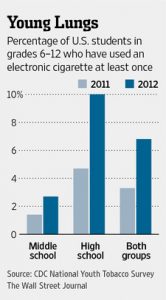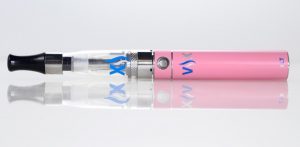A quick search online for “tobacco-free athletes” will yield a bounty of organizations, research, and resources geared to reduce or eliminate tobacco use in sports — particularly among young athletes. However, try the search terms “vapor cigarette athletes,” and you will find website after website touting the benefits athletes can expect from using vapor cigarettes. While vapor cigarettes may be a suitable option for habitual smokers looking to quit using tobacco cigarettes, the vapor cigarette industry is using strong marketing tactics to make this new fad become a mainstay — especially among teens. This tobacco alternative is still new enough that no research has been conducted on the long-term effects of vapor cigarettes.
TERMINOLOGY
 There is a growing divide between adults and teens about vapor cigarettes simply from a difference in nomenclature. Most of the vapor companies have removed the word “cigarette” from their brand and products, and already the terms “e-cigarette” and “vapor cigarette” are outdated. In fact, the act of using one of these devices isn’t called smoking — it’s referred to as “vaping.” In reality though, a vaporizer and an e-cigarette are the exact same thing, which even “Hot Vapes” admits. A survey by the Centers for Disease Control and Prevention found that the number of high school students nationwide who said that they had tried “e-cigarettes” doubled from 2011 to 2012. However, that survey used the term “e-cigarette,” which is not a term used by teens. This calls into question how accurately the C.D.C. was able to determine the prevalence of vapor cigarettes among youth. A New York Times article highlights some of the confusion cause by this abundance of names for the habit.
There is a growing divide between adults and teens about vapor cigarettes simply from a difference in nomenclature. Most of the vapor companies have removed the word “cigarette” from their brand and products, and already the terms “e-cigarette” and “vapor cigarette” are outdated. In fact, the act of using one of these devices isn’t called smoking — it’s referred to as “vaping.” In reality though, a vaporizer and an e-cigarette are the exact same thing, which even “Hot Vapes” admits. A survey by the Centers for Disease Control and Prevention found that the number of high school students nationwide who said that they had tried “e-cigarettes” doubled from 2011 to 2012. However, that survey used the term “e-cigarette,” which is not a term used by teens. This calls into question how accurately the C.D.C. was able to determine the prevalence of vapor cigarettes among youth. A New York Times article highlights some of the confusion cause by this abundance of names for the habit.
The following names can be used interchangeably to identify vapor cigarettes and the use of them:
- [twocolumns]
- e-cig
- vape pen
- vaping
- e-hookah
- electronic cigarette
- vapor cigarette
[/twocolumns]
MARKETING
If I were to make a decision about vapor cigarettes solely based on the numerous ads and commercials, I would guess they are healthy, safe, easily accessible (you can buy them online, and there are no federal age regulations), and most of all — fun. They come in myriad flavors, and the units used to inhale the vapors can become another decorative accessory. With flavors like “Gummy Bear” and “Strawberry Champagne,” vapor cigarettes seem like a really delicious treat. Also, the companies selling the vapor products refer to their users as a “community,” conveying an element of being a “part of something cool.”
As mentioned previously, searching for “vapor cigarette athletes” will guide you to websites which outline the many purported reasons why vaping will improve your athletic performance. After briefly reviewing these (very unprofessional) websites, I could find very little information on how vapor cigarettes help athletes quit smoking tobacco cigarettes and what the process of nicotine reduction would be. Rather, they are presented as a “healthy,” “stigma-free” option for reducing stress. One of the websites even said, “Let’s face it; nicotine feels good.” The original intention of the vapor cigarettes was to help tobacco smokers slowly reduce their addition to nicotine, while avoiding tobacco inhalation. However, current marketing for the e-cigs seems to uplift the unnamed benefits of nicotine as a reason to start using them, regardless of whether or not you previously used tobacco cigarettes.
Teenagers are eagerly receiving this incomplete picture. In a recent segment by NPR, one teen’s comments convey just how ill-informed the ads and commercials are making young people. The piece says, “Thomas Mason, 16, thinks they’re beneficial. ‘And the e-cigarettes is like flavored nicotine, so as far as I think, I think that nicotine is supposed to help you stop smoking,’ Mason says.”
HEALTH RISKS
Unfortunately, nicotine does not help you stop smoking. In fact, nicotine is the very reason why people continue the habit. The e-cigarette companies are publicizing the health benefits of their products and the nicotine in them; however, teens especially should avoid nicotine use. With emerging research indicating the human brain stops developing somewhere after the age of 24 and before the age 28, adolescents’ brains are still susceptible to interference in brain development.
The adolescent brain is in a delicate state as its rewards system matures earlier than the cognitive control systems. Simply put, teens are more vulnerable to addiction. This increased chance of becoming addicted to the nicotine in vapor cigarettes can lead to a host of other problems. One research article points to the potential for long-term mood disorders and responding with behaviors which are “maladaptive in emotional contexts” as a result of nicotine exposure during adolescence. Another article supports this and also indicates memory functions could be harmed through nicotine exposure.
TALK TO YOUR TEEN
The United States as a whole has worked hard to reduce the prevalence of tobacco use among teens. One of the more successful elements of that movement was role models of teens speaking directly to them about the negative effects of smoking. The same model can be applied to vapor cigarettes. As coaches and sport parents, one of your number one concerns is the health and safety of your young athletes. Taking the time to address these issues surrounding vapor cigarettes could make a huge difference in your teen’s choices.


